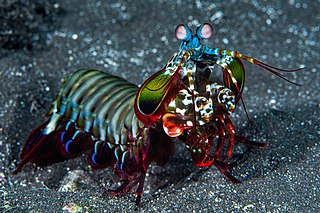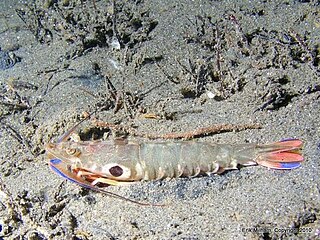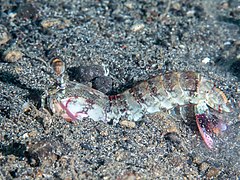
Mantis shrimp are carnivorous marine crustaceans of the order Stomatopoda. Stomatopods branched off from other members of the class Malacostraca around 340 million years ago. Mantis shrimp typically grow to around 10 cm (3.9 in) in length, while a few can reach up to 38 cm (15 in). A mantis shrimp's carapace covers only the rear part of the head and the first four segments of the thorax. Varieties range in colour from shades of brown to vivid colours, with more than 520 species of mantis shrimp known. They are among the most important predators in many shallow, tropical and subtropical marine habitats. However, despite being common, they are poorly understood, as many species spend most of their lives sheltering in burrows and holes.

Zoanthids are an order of cnidarians commonly found in coral reefs, the deep sea and many other marine environments around the world. These animals come in a variety of different colonizing formations and in numerous different colors. They can be found as individual polyps, attached by a fleshy stolon or a mat that can be created from small pieces of sediment, sand and rock. The term "zoanthid" refers to all animals within this order Zoantharia, and should not be confused with "Zoanthus", which is one genus within Zoantharia.

Odontodactylus scyllarus, commonly known as the peacock mantis shrimp, harlequin mantis shrimp, painted mantis shrimp, clown mantis shrimp, rainbow mantis shrimp, or simply mantis shrimp, is a large stomatopod native to the epipelagic seabed across the Indo-Pacific, ranging from the Marianas to East Africa, and as far South as Northern KwaZulu Natal in South Africa.

Salmoneus is a genus of shrimps of the family Alpheidae. Understanding of the genus has grown rapidly, with only 19 known species before 2000, to 69 species as of 2024.

Negaprion is a genus of requiem sharks in the family Carcharhinidae. It contains the two extant species of lemon sharks: the lemon shark of the Americas, and the sicklefin lemon shark of the Indo-Pacific. Both species are large, slow-moving, bulky sharks inhabiting shallow coastal waters, and can be identified by their short, blunt snouts, two dorsal fins of nearly equal size, and uniform yellowish brown or gray coloration.

Lysiosquilla is a genus of mantis shrimp of the family Lysiosquillidae, containing these species:

Squilla mantis is a species of mantis shrimp found in shallow coastal areas of the Mediterranean Sea and the Eastern Atlantic Ocean: it is also known as "pacchero" or "canocchia". Its abundance has led to it being the only commercially fished mantis shrimp in the Mediterranean.

Squilla is a genus of mantis shrimp. It includes the following species:

Eurysquillidae is a family of mantis shrimp. Formerly placed in the superfamily Gonodactyloidea, it has since been recognised that eurysquillids are closer to families in the Squilloidea, and so Eurysquillidae has been placed in its own superfamily, Eurysquilloidea. The family was first described in 1977 by Raymond Manning.

Lysiosquillina maculata, the zebra mantis shrimp, striped mantis shrimp or razor mantis, is a species of mantis shrimp found across the Indo-Pacific region from East Africa to the Galápagos and Hawaiian Islands. At a length up to 40 cm, L. maculata is the largest mantis shrimp in the world. L. maculata may be distinguished from its congener L. sulcata by the greater number of teeth on the last segment of its raptorial claw, and by the colouration of the uropodal endopod, the distal half of which is dark in L. maculata but not in L. sulcata. A small artisanal fishery exists for this species.

Farfantepenaeus is a genus of prawns in the family Penaeidae. Its eight species were formerly included in the genus Penaeus. It was first published as a genus name in 1972 by Rudolf N. Burukovsky, but without the necessary designation of a type species. That situation was corrected by the same author in 1997. The name Farfantepenaeus commemorates the Cuban carcinologist Isabel Pérez Farfante.

Pseudosquillopsis is a genus of mantis shrimp in the family Parasquillidae.

Sicyonia is a genus of prawns, placed in its own family, Sicyoniidae. It differs from other prawns in that the last three pairs of its pleopods are uniramous, rather than biramous as seen in all other prawns.

Gonodactylus is a genus of mantis shrimp, containing the following species:
Gonodactylellus is a genus of mantis shrimp. The genus was first described by Raymond Manning in 1995.

Bathysquillidae is a family of mantis shrimp. It contains two genera and three species. The family was described by Raymond Manning in 1967.

The Pseudosquillidae are a family of mantis shrimp containing four genera and 11 species.

The clade Multicrustacea constitutes the largest superclass of crustaceans, containing approximately four-fifths of all described non-hexapod crustacean species, including crabs, lobsters, crayfish, shrimp, krill, prawns, woodlice, barnacles, copepods, amphipods, mantis shrimp and others. The largest branch of multicrustacea is the class Malacostraca.
Hemisquilla californiensis is a species of mantis shrimp native to the northern Pacific Ocean. H. californiensis is known for smashing prey against rocks using its raptorial claws, as well as its brightly colored telson and eyespots under the tail. H. californiensis is one of the largest and most common mantis shrimp species in California. H. californiensis is one of three subspecies of H. ensigera.

Odontodactylus latirostris is a species of mantis shrimp in the family Odontodactylidae.




















